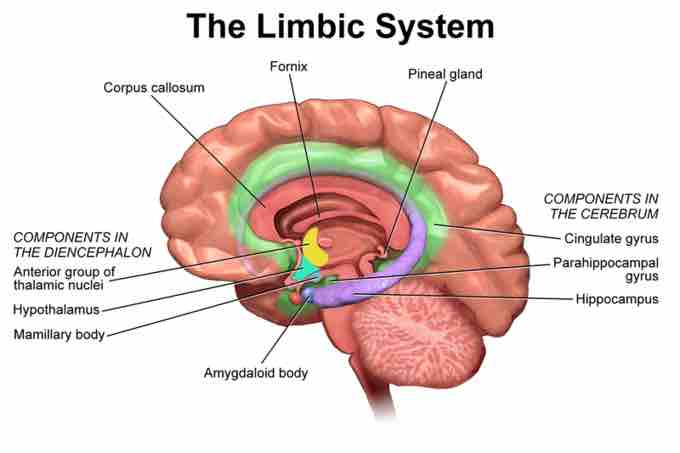The limbic system, or paleomammalian brain, is a set of brain structures in the precortex and subcortex of the brain. It includes the hippocampus, amygdala, anterior thalamic nuclei, septum, limbic cortex, and fornix, and supports a variety of functions including emotion, behavior, motivation, long-term memory, and olfaction. The term "limbic" comes from the Latin limbus, for "border" or "edge," because the limbic system forms the inner border of the cortex.

The Limbic System
This diagram of the limbic system delineates components of the diencephalon and cerebrum.
Limbic System Anatomy
The limbic system consists of various structures that each support distinctive brain functions.
Hippocampus and Associated Structures
- Hippocampus: Required for the formation of long-term memories and implicated in maintenance of cognitive maps for navigation.
- Amygdala: Involved in signaling the cortex of motivationally-significant stimuli, such as those related to reward and fear, and in social functions, such as mating.
- Fornix: A white matter structure that carries signals from the hippocampus to the mammillary bodies and septal nuclei.
- Mammillary body: Important for the formation of memory.
Septal Nuclei
- These lie below the rostrum of the corpus callosum and anterior to the lamina terminalis. The septal nuclei receive reciprocal connections from the olfactory bulb, hippocampus, amygdala, hypothalamus, midbrain, habenula, cingulate gyrus, and thalamus.
Limbic Lobe
A phylogenetically old structure consisting of the following structures:
- Parahippocampal gyrus: Plays a role in the formation of spatial memory
- Cingulate gyrus: Conducts autonomic functions regulating heart rate, blood pressure, and cognitive and attentional processing
- Dentate gyrus: Thought to contribute to the formation of new memories
Additional structures
- Entorhinal cortex: Important memory and associative components
- Piriform cortex: Processes olfactory information
- Fornicate gyrus: Region encompassing the cingulate and parahippocampal gyrus
- Nucleus accumbens: Involved in reward, pleasure, and addiction
- Orbitofrontal cortex: Involved in cognitive processing during decision-making
Limbic System Function
The limbic system operates by influencing the endocrine system and the autonomic nervous system. It is highly interconnected with the nucleus accumbens, the brain's pleasure center, which plays a role in sexual arousal and the "high" derived from certain recreational drugs.
The structures of the limbic system are involved in motivation, emotion, learning, and memory. The limbic system is also tightly connected to the prefrontal cortex. Some scientists contend that this connection is related to the pleasure obtained from solving problems. To cure severe emotional disorders, this connection was sometimes surgically severed, a procedure of psychosurgery called a prefrontal lobotomy. Patients who underwent this procedure often became passive and lacked motivation.